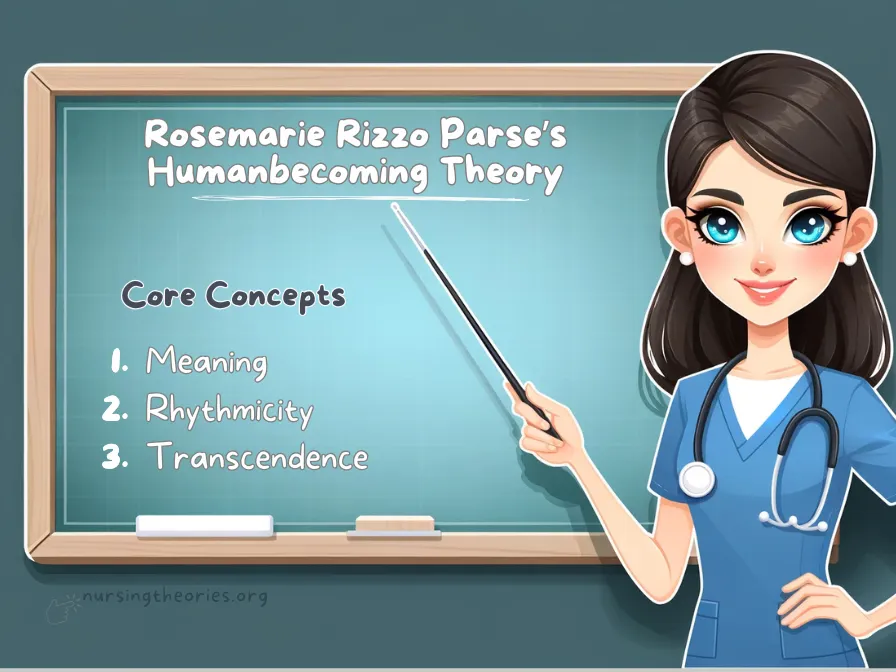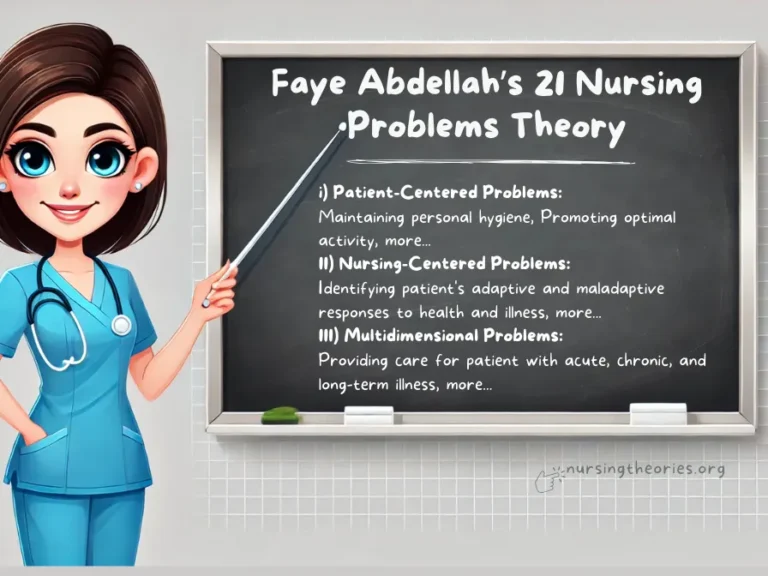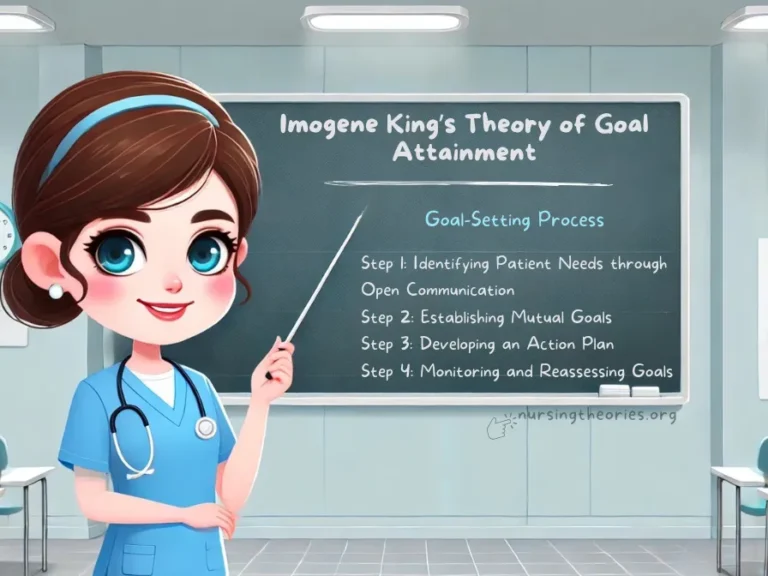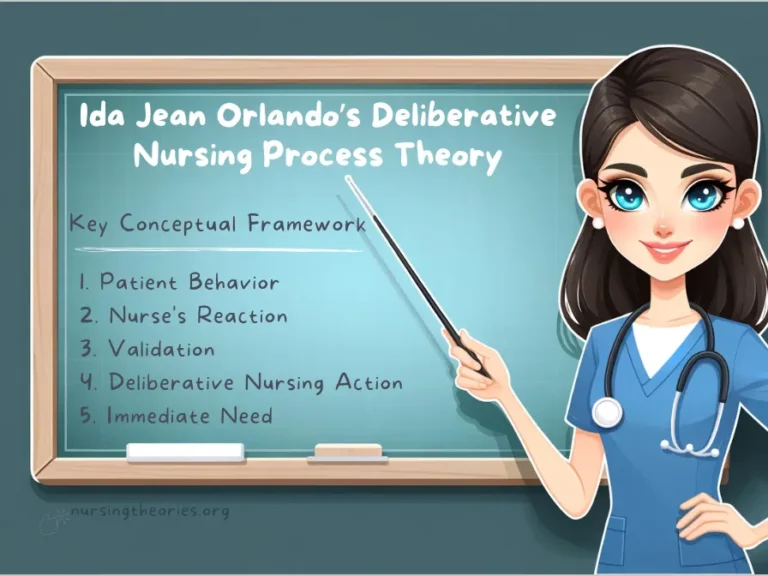Rosemarie Rizzo Parse’s Humanbecoming Theory reshaped the nursing landscape by promoting holistic, patient-centered care.
Emphasizing dignity, freedom, and meaning in health experiences, this theory views health as a dynamic process shaped by each individual’s personal values and life choices.
To learn more about Parse’s contributions, visit Rosemarie Rizzo Parse’s biography.
This article explores the core concepts, practical applications, and real-life case studies to highlight how this theory can guide nursing practice.

What You’ve Learned – Rosemarie Rizzo Parse’s Humanbecoming Theory
- Health is subjective: Parse’s theory asserts that health is not defined solely by medical metrics but by the individual’s perception of well-being.
- Meaning shapes health: Life experiences, including challenges and triumphs, contribute to the unique meaning each person assigns to their health.
- Rhythms influence healing: Health is an evolving process of life rhythms, and understanding these rhythms helps patients achieve balance.
- Transcendence fosters growth: Patients can grow and redefine their well-being by moving beyond current limitations.
- Collaborative care enhances outcomes: Nurses act as facilitators, working with patients to uncover meaning, set goals, and navigate life changes.
Core Concepts of Rosemarie Rizzo Parse’s Humanbecoming Theory
The core concepts of Rosemarie Rizzo Parse’s Humanbecoming Theory provide a framework for understanding health as a constantly evolving process shaped by meaning, rhythms, and transcendence.
These concepts guide nurses in delivering holistic, patient-centered care.
I) Meaning: as a Central Construct in Health
Parse emphasizes that individuals define health and life meaning based on their unique experiences and interpretations.
- Core Principle: Health is subjective, and patients create meaning by reflecting on their life events, decisions, and challenges.
- Example: A breast cancer survivor finds purpose through advocacy work and helping other patients navigate their journey.
- Key Insight: Recognizing meaning in experiences allows patients to redefine health as personal growth, not merely the absence of illness.
- Think of it as… Adding pieces to a mosaic—each experience contributes to the overall picture of one’s life.
II) Rhythmicity: Navigating Life’s Dynamic Flow
Health is an ever-changing rhythm of ups and downs, reflecting life’s natural ebb and flow.
- Core Principle: Patients experience health as a series of intertwined rhythms—rest and activity, joy and sorrow, growth and stagnation.
- Example: A patient managing chronic fatigue learns to listen to their body and balance periods of rest with meaningful activities.
- Key Insight: By acknowledging life’s rhythms, patients develop resilience and the ability to adapt to health fluctuations.
- Think of it as… Riding a wave—accepting and adapting to its rise and fall leads to smoother navigation.
III) Transcendence: Moving Beyond Current Limitations
Transcendence involves patients growing and discovering new possibilities beyond their immediate circumstances.
- Core Principle: Patients can achieve higher well-being by viewing challenges as opportunities for growth and change.
- Example: A patient with limited mobility discovers a new passion for painting, creating a meaningful outlet for self-expression.
- Key Insight: Transcendence allows patients to redefine their identity and purpose despite physical limitations.
- Think of it as… Climbing a mountain—each step may be challenging, but the view from the top brings new perspectives.
Key principles of Parse’s Humanbecoming Theory:
- Health is a personal commitment and process, not a state to achieve
- Humans are indivisible, unpredictable, and always changing
- People co-create their health patterns through relationships with others
- Nursing focuses on bearing witness to patient-chosen life patterns rather than problem-solving
The Nursing Process Through Parse’s Humanbecoming Theory
Step 1: Assessment – Understanding the Patient’s Perspective
Assessment involves gathering subjective data on how patients perceive their health and life experiences.
This step focuses on uncovering their personal meaning of well-being rather than only relying on clinical measurements.
- Example: A nurse assesses how a terminally ill patient defines quality of life, asking about their emotional well-being, relationships, and life goals.
- Key Insight: By understanding patients’ perspectives, nurses can develop care plans that resonate with their values and goals.
- Think of it as… Viewing health through the patient’s lens—each person’s experience shapes their unique health story.
Step 2: Diagnosis – Identifying Life Patterns and Challenges
The nurse identifies patterns in the patient’s experiences that influence their health, such as recurring emotional challenges, behavioral patterns, or environmental factors.
- Example: A patient recovering from surgery repeatedly experiences anxiety related to their inability to return to work, impacting their overall recovery.
- Key Insight: Recognizing emotional and life patterns allows nurses to address underlying issues that hinder healing.
- Think of it as… Spotting patterns in a quilt—each piece connects to the overall fabric of the patient’s experience.
Step 3: Planning – Co-Creating Meaningful Goals
Nurses and patients work together to establish personalized, meaningful goals that address both health outcomes and the patient’s sense of purpose and fulfillment.
- Example: A patient with Parkinson’s disease sets meaningful goals with the nurse, including engaging in social activities and improving mobility through gradual exercise.
- Key Insight: Collaborative goal-setting ensures that care plans align with the patient’s values, enhancing motivation and participation.
- Think of it as… Designing a road trip itinerary—each destination reflects the patient’s personal preferences.
Step 4: Implementation – Supporting Freedom of Choice
The care plan is implemented through interventions that respect the patient’s autonomy and freedom of choice, ensuring that they feel empowered throughout their health journey.
- Example: A nurse supports a patient’s decision to pursue a combination of traditional and alternative treatments for chronic pain management.
- Key Insight: Empowering patients to make decisions fosters a sense of control and engagement in their care.
- Think of it as… Handing the reins to the patient—giving them control over their healing journey while providing guidance.
Step 5: Evaluation – Reflecting on Growth and Transcendence
Nurses evaluate the effectiveness of interventions by reflecting on whether the patient has experienced growth, improved well-being, or achieved meaningful personal outcomes.
- Example: A nurse evaluates whether a patient with depression has gained emotional resilience through counseling and support groups.
- Key Insight: Evaluating growth and adaptation, not just clinical outcomes, ensures holistic and meaningful progress.
- Think of it as… Reviewing a journal—looking back reveals milestones and moments of personal development.
Real-Life Case Studies Using Parse’s Humanbecoming Theory
Case Study 1: Finding Meaning During End-of-Life Care
- Scenario: A 68-year-old patient with terminal lung cancer wishes to focus on emotional closure and family connection during their final months.
- Application: The nurse conducts regular reflective conversations with the patient, helping them express unresolved feelings and mend broken family relationships. A legacy project, including letters to loved ones, is also developed as part of the care plan.
- Key Insight: Supporting patients in finding meaning during end-of-life transitions promotes emotional peace and dignity.
- Think of it as… Writing the final chapter of a book—every page reflects important lessons and experiences, leaving a lasting impact.
Case Study 2: Empowering a Post-Surgery Patient to Regain Confidence
- Scenario: A 45-year-old patient recovering from a leg amputation struggles with body image issues and self-doubt.
- Application: The nurse collaborates with the patient to create a care plan that includes gradual physical rehabilitation, peer support groups, and expressive writing exercises. As the patient progresses, they discover a passion for adaptive sports.
- Key Insight: Helping patients transcend their perceived limitations fosters new self-identities and sources of fulfillment.
- Think of it as… Rebuilding a home after a storm—each step restores confidence and stability, creating a stronger foundation.
Case Study 3: Balancing Rhythms of Life for a Caregiver
- Scenario: A family caregiver providing care for their elderly parent with dementia experiences burnout, emotional fatigue, and loss of personal identity.
- Application: The nurse supports the caregiver by creating a plan that includes respite care services, mindfulness exercises, and structured time for personal hobbies. Gradually, the caregiver regains balance and a renewed sense of purpose.
- Key Insight: Recognizing and adapting to life’s rhythms allows caregivers to maintain their well-being and continue providing effective care.
- Think of it as… Dancing to changing tempos—embracing the rhythm helps maintain harmony without burnout.
Modern Implications of Parse’s Humanbecoming Theory in Healthcare
I) Promoting Patient Empowerment through Autonomy
Parse’s theory underscores the importance of respecting a patient’s freedom to make choices about their health, which empowers them to take control of their well-being.
- Example: A patient with diabetes works closely with the nurse to design a personalized diet and exercise plan, ensuring it aligns with their lifestyle and beliefs.
- Key Insight: Empowering patients through decision-making improves their sense of control and leads to better long-term health outcomes.
- Think of it as… Handing over the steering wheel—patients drive their own care journey with nurses offering guidance along the way.
II) Enhancing Mental and Emotional Resilience
Parse’s theory helps patients cultivate resilience by viewing challenges as opportunities for growth and discovery.
Nurses can use this framework to foster coping mechanisms that support emotional well-being.
- Example: A patient undergoing chemotherapy develops a routine that includes mindfulness exercises, journaling, and regular peer support sessions to manage treatment-related stress.
- Key Insight: Emotional resilience enables patients to adapt more effectively to changing health conditions and maintain a positive outlook.
- Think of it as… Building a tree with deep roots—strong emotional foundations help patients weather life’s storms.
III) Addressing Quality of Life in Palliative Care
In palliative care, Parse’s emphasis on meaning and dignity ensures that patients experience a high quality of life, even as they face life-limiting conditions.
- Example: A palliative care patient creates memory books with their family as part of the nurse’s plan to support emotional closure and meaningful interactions.
- Key Insight: Quality of life extends beyond physical comfort; emotional, spiritual, and relational needs are equally essential.
- Think of it as… Tending a garden—nurturing various aspects ensures flourishing even during difficult times.
Challenges and Limitations of Applying Parse’s Humanbecoming Theory
I) Time Constraints in Clinical Settings
In fast-paced clinical environments, nurses often face limited time to fully implement the reflective and individualized care required by Parse’s theory.
- Example: An emergency room nurse may not have the time to conduct in-depth conversations about a patient’s personal meaning of health.
- Key Insight: Streamlining assessment tools and integrating reflective practices into routine care can help address this challenge.
- Think of it as… Managing time like a juggler—balancing immediate clinical tasks while making space for meaningful interactions.
II) Cultural and Personal Differences
Patients come from diverse cultural backgrounds, and their beliefs about health and meaning can vary, making it difficult for nurses to apply a universal approach.
- Example: A patient from a culture that values collective decision-making may prefer family involvement in their care, while another patient may prioritize individual autonomy.
- Key Insight: Nurses must practice cultural competence and tailor interventions based on the patient’s values, beliefs, and preferences.
- Think of it as… Learning a new language—understanding different cultural perspectives helps improve communication and care outcomes.
III) Resistance to Emotional Exploration
Some patients may resist discussing personal or emotional topics, which could hinder the process of uncovering meaningful insights into their health experiences.
- Example: A patient dealing with a recent cancer diagnosis may initially refuse to discuss their fears or long-term concerns.
- Key Insight: Building trust gradually and using therapeutic communication techniques can help patients feel safe and open to exploring their emotions.
- Think of it as… Unlocking a door with the right key—patience and empathy can reveal the path to meaningful conversations.
Rosemarie Rizzo Parse’s Humanbecoming Theory Quiz
1) What is the central focus of Rosemarie Rizzo Parse’s Humanbecoming Theory?
a) Medical diagnosis and treatment
b) Patient-centered care based on meaning and choice
c) Medication adherence
d) Routine clinical assessments
2) Which of the following best describes the concept of rhythmicity in Parse’s theory?
a) Static health outcomes
b) Health as a series of interconnected life rhythms
c) Eliminating all fluctuations in health
d) Prioritizing physical interventions only
3) What role does transcendence play in Parse’s Humanbecoming Theory?
a) Limiting patients to fixed health outcomes
b) Helping patients grow beyond current limitations
c) Encouraging dependence on healthcare providers
d) Focusing solely on disease management
4) Why is collaboration important in Parse’s nursing process?
a) To reduce the patient’s involvement
b) To co-create goals that align with the patient’s values and meaning of health
c) To develop standardized treatment plans
d) To expedite clinical procedures
5) How can nurses address resistance to emotional exploration during care?
a) By ignoring the patient’s preferences
b) By building trust and using therapeutic communication
c) By focusing only on physical symptoms
d) By limiting discussions to clinical outcomes
Quiz Answers with Rationale
- b) Patient-centered care based on meaning and choice
Rationale: Parse’s theory emphasizes individualized, holistic care where patients are active participants in defining their health experiences. - b) Health as a series of interconnected life rhythms
Rationale: Parse views health as an evolving process of life rhythms, balancing ups and downs that contribute to overall well-being. - b) Helping patients grow beyond current limitations
Rationale: Transcendence in Parse’s theory allows patients to adapt, grow, and redefine their identities despite health challenges. - b) To co-create goals that align with the patient’s values and meaning of health
Rationale: Collaboration ensures that care plans reflect what matters most to the patient, making interventions more effective. - b) By building trust and using therapeutic communication
Rationale: Establishing a trusting relationship encourages patients to open up and explore their emotions without fear of judgment.
Questions and Answers on Rosemarie Rizzo Parse’s Humanbecoming Theory
Q1: How does Parse’s Humanbecoming Theory differ from traditional medical models?
A: Unlike traditional models focused on disease treatment, Parse’s theory emphasizes patient-centered, holistic care that reflects the patient’s personal meaning of health.
Q2: How can nurses apply rhythmicity in practice?
A: By recognizing and working with patients’ life rhythms—such as balancing rest and activity—nurses can help patients achieve harmony in their daily lives.
Q3: Why is patient empowerment important in Parse’s theory?
A: Empowering patients fosters autonomy, allowing them to take ownership of their health decisions and outcomes.
Q4: What role does the nurse play in Parse’s model of care?
A: Nurses act as facilitators, guiding patients through reflective conversations, co-creating care plans, and supporting personal growth.
Q5: How does Parse’s theory address emotional and spiritual needs?
A: By integrating emotional and spiritual exploration into care, Parse’s theory promotes holistic healing and meaningful personal transformation.
Conclusion of Rosemarie Rizzo Parse’s Humanbecoming Theory
Rosemarie Rizzo Parse’s Humanbecoming Theory redefines the role of nursing by focusing on the patient’s subjective experience of health.
By fostering collaboration, meaning, and growth, this theory empowers patients to take an active role in their well-being.
Its applications in acute, chronic, and community care highlight its versatility and continued relevance in modern nursing.
Final Reflective Question: How can you apply Parse’s principles of meaning, rhythmicity, and transcendence to create patient-centered care plans in your nursing practice?




